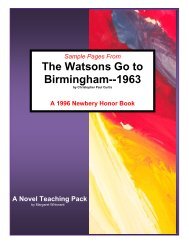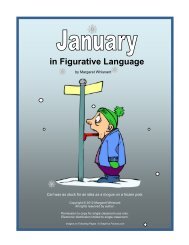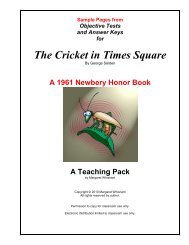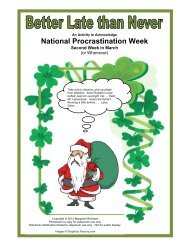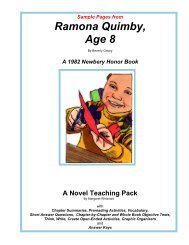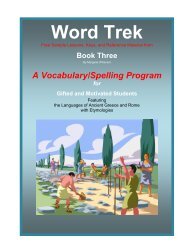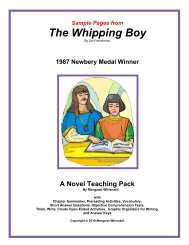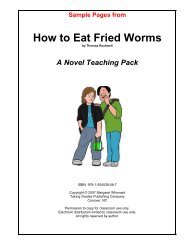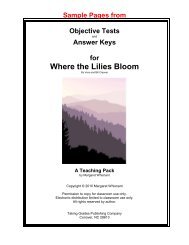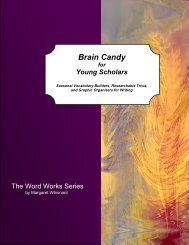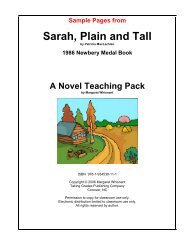The Pinballs - Taking Grades Publishing Company
The Pinballs - Taking Grades Publishing Company
The Pinballs - Taking Grades Publishing Company
Create successful ePaper yourself
Turn your PDF publications into a flip-book with our unique Google optimized e-Paper software.
Using the Words. . .<br />
Other activities, which pull terms from the lists in random order, lead students through a variety of word<br />
studies which include<br />
sentence usage<br />
word forms<br />
synonyms and antonyms<br />
anagrams<br />
categories<br />
word groups/connections<br />
Copyright © 2009 Margaret Whisnant<br />
<strong>Taking</strong> <strong>Grades</strong> <strong>Publishing</strong> <strong>Company</strong>, Conover, NC 4<br />
word types (acronyms, onomatopoeia, etc.)<br />
scrambled sentences<br />
analogies<br />
whole-class/group games<br />
etymologies<br />
4. Assessment<br />
<strong>The</strong> two sections in this portion of the teaching pack offer a wealth of materials designed to build a strong foundation<br />
for student progression to higher level thinking skills. <strong>The</strong> operative phrase is basic comprehension.<br />
Short Answer Questions<br />
Short answer questions for each chapter (or groups of chapters) are the first available assessment tools.<br />
<strong>The</strong> items encourage (and check) careful reading. Some require the reader to recognize a major event or<br />
idea while others involve finding a minor detail. <strong>The</strong> questions are in sequence with the pages they cover, but<br />
they are not designed to call attention to plot construction or other story elements.<br />
<strong>The</strong> short answer questions can be used as<br />
student reading guides<br />
pop quizzes<br />
discussion groups guides<br />
conferencing with individual students<br />
Objective Tests<br />
<strong>The</strong> objective tests have multiple functions. In addition to their obvious application, they also serve as<br />
tools that can improve comprehension skills by providing practice in understanding plot structure and<br />
recognizing important story elements.<br />
Rationale:<br />
Focus on the Plot. . .<br />
Whether they are aware of their ability or not, all good readers sense the rhythm of the connected<br />
events that compose the plot of a novel, and consequently comprehend the story. <strong>The</strong>y are in tune with<br />
cause and effect, behavior and consequence, sequence—the heartbeat of the narrative.<br />
This “plot rhythm” forms the framework for the objective tests. <strong>The</strong> chain of events that tell the story have<br />
been pulled from the novel and reformatted into a series of sequential questions, none of which require<br />
interpretation. <strong>The</strong>y are intended to draw student attention to the fact that something happened, not to<br />
what the incident means. That comes later.<br />
In addition to their testing function, teachers may use the pages to strengthen their students’ ability to<br />
Summarize: With only the questions as a guide, have students write a summary of the chapter. For a set of<br />
ten questions, limit the number of sentences they may write to seven or fewer. When they work with twenty<br />
or more questions, allow no more than twelve sentences.<br />
Report the News: Ask your students to write a newspaper article based on the events identified in a set of<br />
questions and the who, what, when, where, why elements. Some information needed to complete this<br />
assignment may be located in previous chapters.<br />
Twist the Plot: Choose one or two questions from each chapter and change its answer—true to false, no to<br />
yes, etc.—to demonstrate how changing a single (or several) events would (or would not) change the story.<br />
This process can be used to help students become proficient in distinguishing major plot movers from minor<br />
story details.<br />
<strong>The</strong> Characters. . .<br />
Too often, when they are asked to describe a story character’s personality, the only answer many<br />
students can muster is “nice.” This portion of the Novel Teaching Pack, coupled with related activities from<br />
Think, Write, Create, is a well of opportunities for those teachers who wish to eradicate “nice” from their<br />
students’ vocabularies!<br />
Questions that identify a character’s personality and/or motivation are purposely and carefully included<br />
with the plot movers. Again, the questions do not require interpretation. <strong>The</strong>y simply establish that<br />
someone did or said something—knowledge that is invaluable when character analysis is required.



